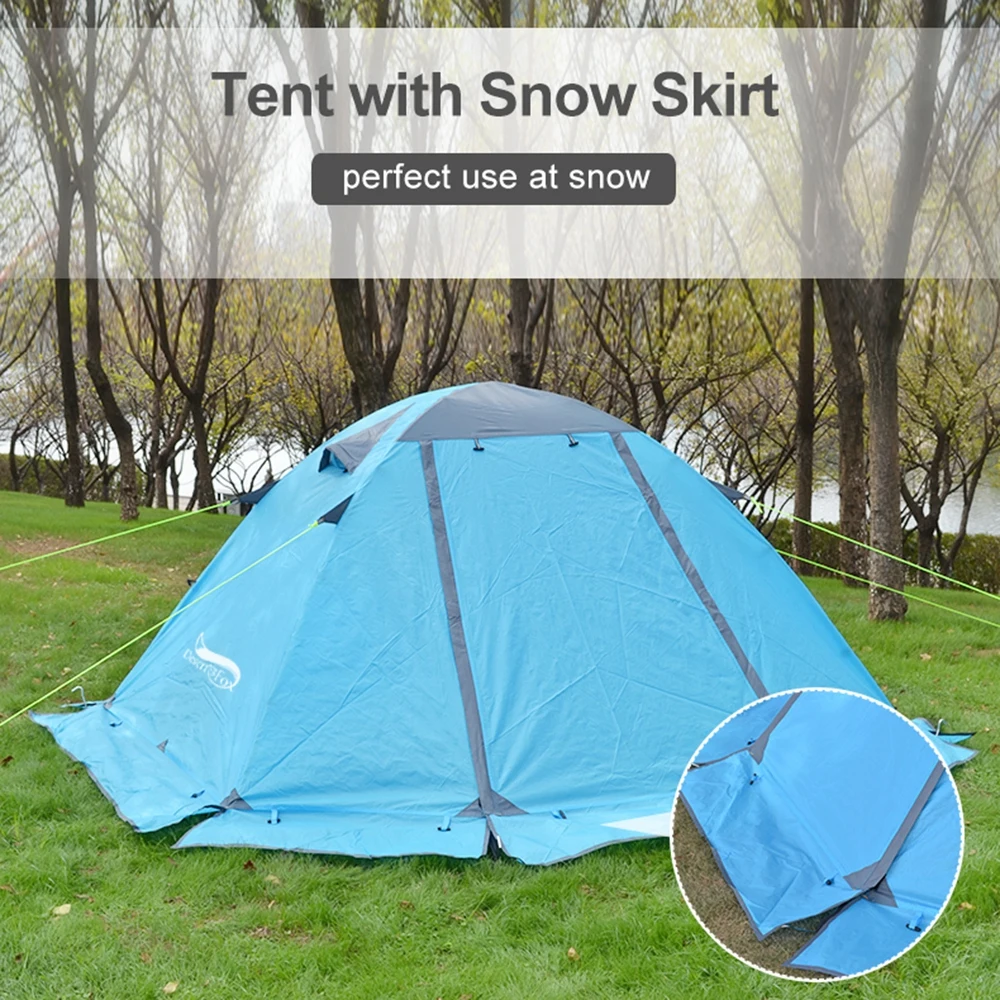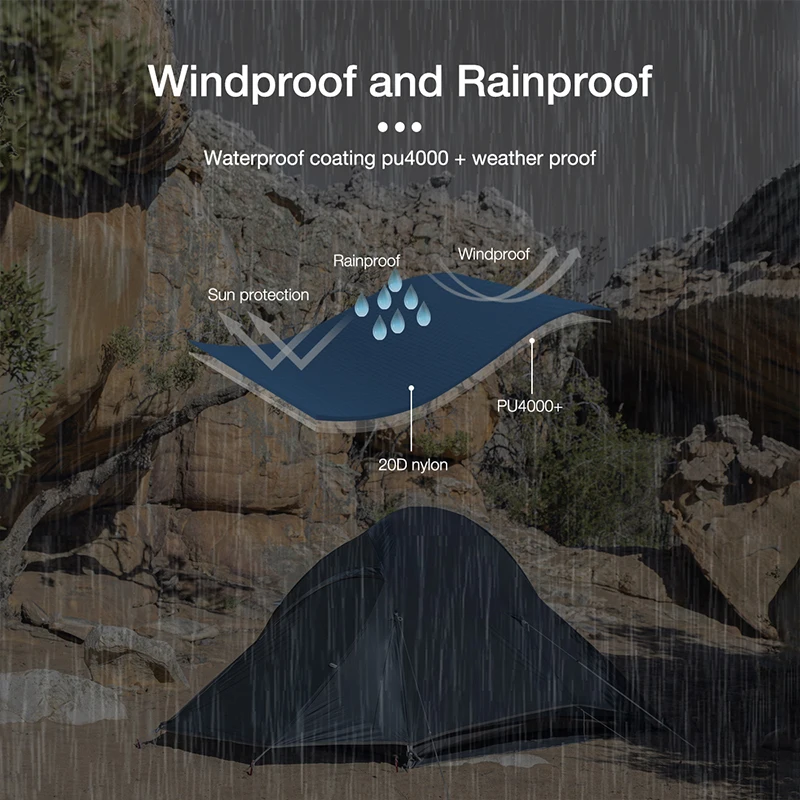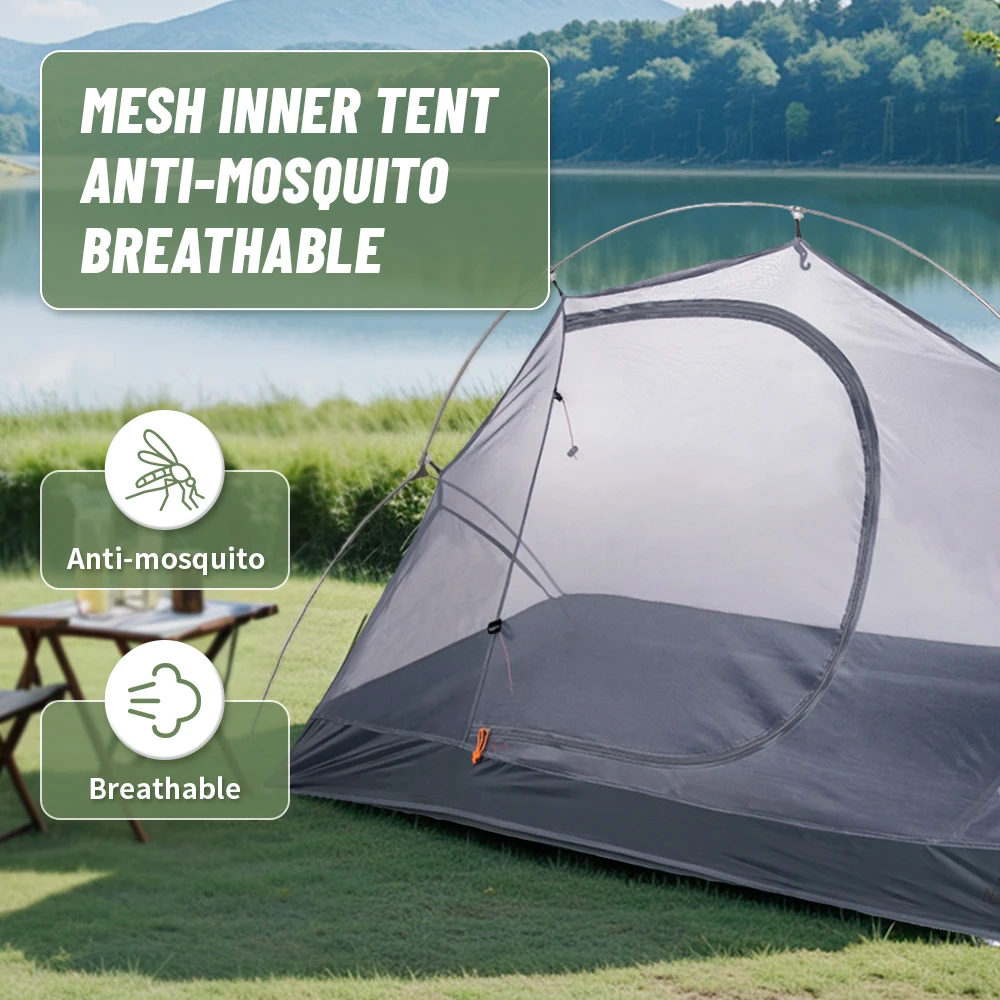When shopping for a tent, you’ll often see waterproof ratings like “3000mm” prominently displayed on product descriptions. But what does this number actually mean, and more importantly—is it enough to keep you dry when the clouds open up? This comprehensive guide will help you understand tent waterproofing so you can make the right choice for your outdoor adventures.
Understanding Waterproof Ratings: What Does 3000mm Actually Mean?
Waterproof ratings for tents are measured using what’s called a hydrostatic head (HH) test. This scientific-sounding term simply refers to how much water pressure a fabric can withstand before leaking.
Here’s what the 3000mm rating specifically means:
- A 3000mm waterproof rating means the fabric can withstand a column of water 3000mm (about 9.8 feet) tall before water seeps through
- During testing, fabric is placed under a clear tube that gets filled with water until leakage occurs
- When three droplets penetrate through the fabric, the height of the water column at that point determines the rating
This measurement system helps differentiate between merely water-resistant materials (which shed light rain but eventually soak through) and truly waterproof fabrics (which can withstand sustained water pressure).
Looking at the full spectrum of tent ratings gives helpful context:
- 1000-1500mm: Minimal protection, suitable only for light drizzle
- 2000-3000mm: Standard protection, handles moderate rainfall
- 3000-5000mm: Good to excellent protection, stands up to heavy downpours
- 5000mm+: Extreme protection for severe weather conditions
The pressure from rainfall varies significantly based on conditions. Light rain might exert only 300-500mm of pressure, while heavy rain combined with wind can create pressure exceeding 2000mm. More comprehensive understanding of tent waterproof ratings can help you evaluate tents beyond just the numbers.
The Short Answer: Is 3000mm Waterproof Enough?
Yes, a 3000mm waterproof rating is generally sufficient for most typical camping scenarios. This level provides reliable protection against moderate to heavy rainfall and is considered a good all-around waterproof rating for three-season camping.
A tent with 3000mm waterproofing will keep you dry during:
– Weekend camping trips in variable weather conditions
– Extended moderate rainfall events
– Most thunderstorms (provided the tent is properly set up)
The 3000mm rating hits a sweet spot in tent design: it offers substantial protection without requiring the heavier, stiffer, less breathable fabrics needed for higher ratings. This makes it an excellent compromise for most recreational campers.
However, it’s crucial to understand that the hydrostatic head rating is just one factor among many that determine how dry you’ll stay. The overall waterproof performance depends on multiple elements working together as a system. For instance, even when selecting compact shelters for two campers, factors like seam construction and tent design play equally important roles in keeping water out.
When 3000mm Waterproofing Excels (And When It Doesn’t)
Understanding when a 3000mm waterproof rating is appropriate—and when you might need more—can save you from an uncomfortably damp camping experience.
| Conditions | Is 3000mm Enough? | Notes |
|---|---|---|
| Light to moderate rain | Yes | Excellent performance in these conditions |
| Heavy but brief showers | Yes | Performs well when properly pitched |
| Extended heavy rainfall | Usually | May eventually show minor seepage points |
| Driving rain with strong winds | Borderline | Wind pushes water harder against fabric |
| Camping in very wet regions | Borderline | Consider higher rating for peace of mind |
| Winter camping with snow load | No | Snow creates sustained pressure requiring 4000mm+ |
| Expedition use in extreme conditions | No | Look for 4000-10000mm ratings |
The tent floor (groundsheet) typically requires higher waterproof ratings than the rainfly because:
- The floor supports direct weight from people and gear, creating more pressure
- It’s in constant contact with potentially wet ground
- Pressure points (knees, gear corners) concentrate force in small areas
For most three-season camping in temperate climates, a 3000mm tent will serve you well. However, if you frequently camp in extremely wet environments like the Pacific Northwest or enjoy winter camping, investing in higher waterproof ratings might be worthwhile. Those seeking gear for harsh winter conditions should explore specialized winter camping tents with higher waterproof ratings and snow-specific design features.

Beyond Ratings: Critical Waterproofing Factors That Matter More
While the hydrostatic head rating gets most of the attention, several other factors often have an even greater impact on whether you stay dry:
Seam Sealing Quality
– Stitching creates thousands of tiny holes where water can penetrate
– Properly taped or sealed seams are essential regardless of fabric rating
– Factory-taped seams are typically more consistent than DIY sealing
– Some budget tents skip this crucial step, leading to leaks despite good HH ratings
Tent Design Features
– Full-coverage rainfly that extends close to the ground
– Adequate vestibules to keep wet gear outside sleeping area
– Strategic door positioning away from prevailing weather
– Proper peak height and roof slope to prevent water pooling
Setup and Tensioning
– A loosely pitched tent allows fabric to sag, creating pools that eventually leak
– Proper guy lines and tensioning distributes force and maintains water runoff
– Site selection (avoiding depressions where water collects) can be more important than HH rating
Zipper Protection
– Quality storm flaps over zippers prevent water entry at vulnerable points
– Waterproof zippers or covered designs matter more in driving rain than higher HH ratings
The essential design elements of waterproof tents combine to create a complete system that either succeeds or fails at keeping water out. A well-designed 3000mm tent often outperforms a poorly designed 5000mm tent in real-world conditions.
Fabric Coatings and Technology: Why All 3000mm Ratings Aren’t Equal
Not all 3000mm waterproof tents offer the same level of protection because the technology behind the waterproofing varies significantly:
Polyurethane (PU) Coatings
– Most common and generally least expensive
– Typically provides good initial waterproofing
– Tends to break down faster, especially with UV exposure
– Can become hydrolyzed (break down) in humid storage conditions
– Often needs re-waterproofing after moderate use
Silicone Coatings (Silnylon/Silpoly)
– More expensive but significantly more durable
– Better long-term water resistance
– Superior UV resistance
– Often maintains waterproofing for the life of the tent
– A 2000-3000mm silicone-treated fabric may outperform a higher-rated PU coating after extended use
Durable Water Repellent (DWR) Finishes
– Surface treatments that make water bead and roll off
– Complement the main waterproof coating
– Prevent “wetting out” where fabric becomes saturated on the surface
– Regular refreshing maintains performance
The quality of application matters tremendously. A precisely applied 3000mm coating will outperform a sloppy 4000mm coating. Premium tents often feature multiple layers or specialized application processes that enhance durability.
Understanding these differences helps explain why two tents with identical 3000mm ratings might perform very differently in the field. The materials used in waterproof hiking gear involve complex trade-offs between waterproofness, durability, weight, and breathability.
The Often-Overlooked Groundsheet Factor
When evaluating tent waterproofing, many campers focus exclusively on the rainfly while overlooking the equally important groundsheet (floor).
The floor of your tent requires special consideration because:
- It bears direct weight from occupants and gear, creating much higher pressure against water
- A person kneeling on a tent floor creates approximately 8-10 times more pressure than rainfall
- Groundsheets are in constant contact with potentially wet surfaces
- Abrasion from movement can wear down waterproofing over time
For these reasons, quality tent manufacturers typically use higher waterproof ratings for tent floors than for rainflies:
– Entry-level tents: 2000-3000mm floor
– Mid-range tents: 3000-5000mm floor
– Premium tents: 5000-10,000mm+ floor
Bathtub floor designs, where the floor material extends several inches up the tent walls, provide additional protection regardless of the specific HH rating. This design prevents splashing and ground-level water from entering the tent.
If camping on very wet ground, consider adding a footprint (ground cloth) underneath your tent for an extra layer of protection. Proper maintenance of waterproof gear is especially important for groundsheets since they take the most abuse during camping trips.
Condensation vs. Leaks: Solving the Mystery of Tent Moisture
One of the most common tent “waterproofing” complaints actually has nothing to do with the tent’s HH rating at all. Condensation is frequently mistaken for leaks, leading campers to believe their tent isn’t waterproof enough.
Q: Why do I wake up with water droplets inside my tent even when it’s not raining?
A: This is almost always condensation, not leaking. When warm, humid air (from your breathing and body heat) meets the cooler tent walls, moisture condenses on the surface.
Q: How much moisture can a person produce overnight?
A: A single person can release up to a pint of water through breathing and perspiration during an 8-hour sleep period.
Q: How can I tell if it’s condensation or a leak?
A: Condensation typically:
– Forms evenly on interior surfaces, particularly the ceiling and upper walls
– Appears worst in the morning or when temperature differences are greatest
– Happens even during clear weather
– Is worse with multiple occupants
Leaks typically:
– Occur in specific spots, often near seams or zippers
– Only happen during rainfall
– Create consistent dripping or running water
– May leave water stains
The solution to condensation isn’t higher waterproof ratings but better ventilation. Waterproof backpacking tents with adequate ventilation features like mesh panels and adjustable vents can significantly reduce condensation while maintaining weather protection.

Real-World Waterproofing: Maintenance and Longevity
Even the most waterproof tent will eventually lose its effectiveness without proper care. Understanding how waterproofing degrades helps you maintain protection regardless of the initial rating.
Key factors that reduce waterproof performance over time:
UV Exposure
– Ultraviolet rays break down waterproof coatings
– PU coatings are especially vulnerable
– Just a few weeks of continuous sun exposure can significantly degrade waterproofingPhysical Abrasion
– Folding, stuffing, and general use creates microscopic cracks in coatings
– Floor materials suffer the most abrasion damage
– Sand and dirt accelerate coating deteriorationImproper Storage
– Storing a tent damp promotes mildew and coating breakdown
– Heat accelerates chemical deterioration of waterproof treatments
– Compressed storage stresses coating adhesion
To extend the life of your tent’s waterproofing:
- Always dry completely before storage
- Apply appropriate waterproofing treatments before they’re needed
- Clean gently with non-detergent cleaners
- Minimize direct sunlight exposure when not in use
- Store loosely in a cool, dry place
Mastering proper tent setup techniques also reduces strain on waterproof coatings by ensuring even tension and preventing pooling that can force water through the fabric.
Making Your Decision: Is 3000mm Right for Your Adventures?
To determine if a 3000mm waterproof rating meets your needs, consider your specific camping style and conditions:
For Weekend Warriors (Occasional Use)
– 3000mm is typically more than adequate
– Focus more on quality construction and seam sealing
– Consider your local climate more than arbitrary numbers
For Frequent Campers
– 3000mm works well for most 3-season camping
– Consider higher ratings (3000-5000mm) for groundsheets
– Prioritize quality over ratings, especially seam construction
For Extreme Conditions/Locations
– Look beyond 3000mm for consistently wet environments
– Consider 4000mm+ ratings for alpine or winter use
– Invest in silicone-treated fabrics for long-term performance
For Backpackers (Weight-Conscious)
– A well-designed 3000mm tent often provides the best balance of weight and protection
– Silicone-treated fabrics offer better durability-to-weight ratios
– Consider supplementing with tarp shelter in extremely wet conditions
Remember that higher ratings often come with trade-offs in weight, packability, and breathability. A good 3000mm tent with quality construction will serve most campers better than a poorly made tent with higher ratings. For specialized needs, explore purpose-built waterproof camping tents designed for specific environmental conditions.
FAQ: Your Top Questions About Tent Waterproofing
Q: What’s the minimum HH rating for a tent to be considered waterproof?
A: Generally, 1500mm is considered the minimum for basic waterproofness, but 2000-3000mm is recommended for reliable protection in typical rain conditions.
Q: Do expensive tents always have better waterproofing?
A: Not necessarily. While premium tents often feature better overall construction and materials, the correlation between price and HH rating isn’t direct. Some affordable tents offer excellent waterproofing but may sacrifice in other areas like weight or durability.
Q: Can I add waterproofing to a tent with insufficient rating?
A: Yes, you can enhance waterproofing with aftermarket sprays and seam sealers, but these treatments typically don’t increase the actual HH rating significantly. They’re better for restoring aged waterproofing than upgrading inadequate protection.
Q: How often should I re-waterproof my tent?
A: It depends on usage, but generally every 10-20 nights of use or when you notice water no longer beading on the surface. UV exposure accelerates degradation, so sun-exposed tents need more frequent treatment.
Q: Is a footprint necessary with a 3000mm floor?
A: Not strictly necessary, but a footprint provides additional protection against abrasion and moisture, extending the life of your tent floor. It’s particularly valuable on rough or wet ground.
Q: Can a tent be too waterproof?
A: Yes, in a sense. Higher waterproof ratings often come with reduced breathability, which can increase condensation. The most waterproof tents aren’t necessarily the most comfortable in all conditions.
When choosing the ultimate compact shelter for two, balance waterproof ratings with other important features like ventilation, weight, and durability for the best overall experience.
The Final Verdict: Balanced Protection for Most Adventures
After examining all aspects of tent waterproofing, we can confidently say that a 3000mm waterproof rating provides sufficient protection for most recreational campers across a wide range of conditions. This rating hits the sweet spot of reliable waterproofing without unnecessary sacrifices in weight, breathability, or cost.
Remember these key takeaways:
- A 3000mm rating handles moderate to heavy rain effectively
- The quality of seam sealing and overall construction matters more than small differences in HH ratings
- Consider higher ratings for groundsheets and extreme conditions
- Proper setup and maintenance significantly impact real-world performance
- Ventilation is crucial for managing condensation regardless of waterproof rating
The best approach is to consider your specific camping needs rather than simply chasing the highest numbers. For most weekend camping trips, family outings, and even multi-day backpacking adventures in reasonable conditions, a well-designed 3000mm tent from a reputable manufacturer will keep you comfortably dry.
At Explore Elements, we carefully evaluate each tent’s complete waterproofing system beyond just the numbers, ensuring reliable performance when it matters most—during your precious time outdoors.


